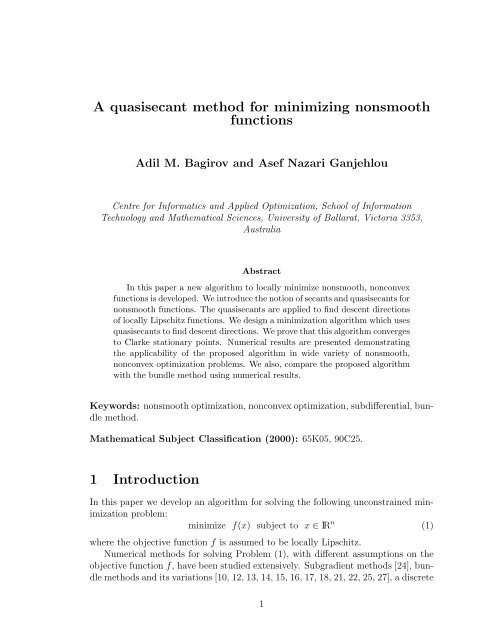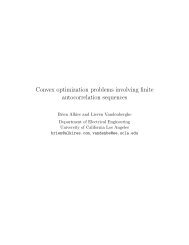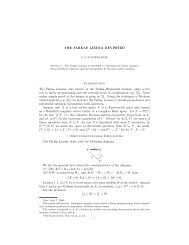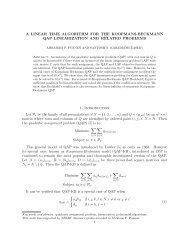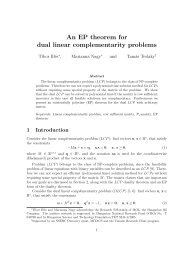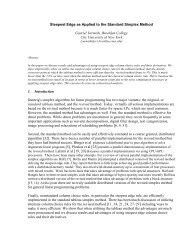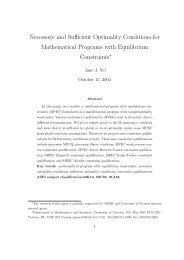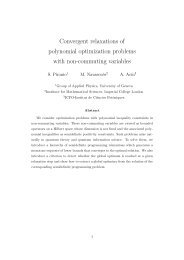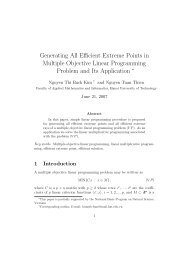A quasisecant method for minimizing nonsmooth functions 1 ...
A quasisecant method for minimizing nonsmooth functions 1 ...
A quasisecant method for minimizing nonsmooth functions 1 ...
Create successful ePaper yourself
Turn your PDF publications into a flip-book with our unique Google optimized e-Paper software.
A <strong>quasisecant</strong> <strong>method</strong> <strong>for</strong> <strong>minimizing</strong> <strong>nonsmooth</strong><br />
<strong>functions</strong><br />
Adil M. Bagirov and Asef Nazari Ganjehlou<br />
Centre <strong>for</strong> In<strong>for</strong>matics and Applied Optimization, School of In<strong>for</strong>mation<br />
Technology and Mathematical Sciences, University of Ballarat, Victoria 3353,<br />
Australia<br />
Abstract<br />
In this paper a new algorithm to locally minimize <strong>nonsmooth</strong>, nonconvex<br />
<strong>functions</strong> is developed. We introduce the notion of secants and <strong>quasisecant</strong>s <strong>for</strong><br />
<strong>nonsmooth</strong> <strong>functions</strong>. The <strong>quasisecant</strong>s are applied to find descent directions<br />
of locally Lipschitz <strong>functions</strong>. We design a minimization algorithm which uses<br />
<strong>quasisecant</strong>s to find descent directions. We prove that this algorithm converges<br />
to Clarke stationary points. Numerical results are presented demonstrating<br />
the applicability of the proposed algorithm in wide variety of <strong>nonsmooth</strong>,<br />
nonconvex optimization problems. We also, compare the proposed algorithm<br />
with the bundle <strong>method</strong> using numerical results.<br />
Keywords: <strong>nonsmooth</strong> optimization, nonconvex optimization, subdifferential, bundle<br />
<strong>method</strong>.<br />
Mathematical Subject Classification (2000): 65K05, 90C25.<br />
1 Introduction<br />
In this paper we develop an algorithm <strong>for</strong> solving the following unconstrained minimization<br />
problem:<br />
minimize f(x) subject to x ∈ IR n (1)<br />
where the objective function f is assumed to be locally Lipschitz.<br />
Numerical <strong>method</strong>s <strong>for</strong> solving Problem (1), with different assumptions on the<br />
objective function f, have been studied extensively. Subgradient <strong>method</strong>s [24], bundle<br />
<strong>method</strong>s and its variations [10, 12, 13, 14, 15, 16, 17, 18, 21, 22, 25, 27], a discrete<br />
1
gradient <strong>method</strong> [1, 2, 4], a gradient sampling <strong>method</strong> [7] and <strong>method</strong>s based on<br />
smoothing techniques [23] are among them.<br />
Subgradient <strong>method</strong>s are quite simple, however, they are not effective to solve<br />
many <strong>nonsmooth</strong> optimization problems. Algorithms based on smoothing techniques<br />
are applicable only to the special class of <strong>nonsmooth</strong> <strong>functions</strong> such as the<br />
maximum <strong>functions</strong>, max-min type <strong>functions</strong>. Bundle type algorithms are more<br />
general algorithms and they build up in<strong>for</strong>mation about the subdifferential of the<br />
objective function using ideas known as bundling and aggregation. One of the important<br />
features of bundle <strong>method</strong>s is that they use subgradients from previous<br />
iterations which are still relevant at the current iteration. Relevancy here means<br />
that subgradients from those iterations are still good underestimator at the current<br />
iteration. In the case of convex <strong>functions</strong>, it is easy to identify relevant subgradients<br />
from the previous iterations, and bundle type algorithms are known to be<br />
very efficient <strong>for</strong> <strong>nonsmooth</strong>, convex problems. For nonconvex <strong>functions</strong> subgradient<br />
in<strong>for</strong>mation is meaningful only locally and must be discounted when no longer<br />
relevant. Special rules have to be designed to identify those irrelevant subgradients.<br />
As a result bundle type algorithms are more complicated in the nonconvex case [7].<br />
The gradient sampling <strong>method</strong> proposed in [7] does not require any rules <strong>for</strong><br />
discounting irrelevant subgradients. It is a stochastic <strong>method</strong> which relies on the<br />
fact that locally Lipschitz <strong>functions</strong> are almost everywhere differentiable. At each<br />
iteration of this <strong>method</strong> a given number of gradients are evaluated from some neighborhood<br />
of a current point.<br />
In this paper, we propose a new algorithm <strong>for</strong> solving Problem (1). It is efficient<br />
<strong>for</strong> minimization of <strong>nonsmooth</strong> nonconvex <strong>functions</strong>. We introduce the notions of a<br />
secant and a <strong>quasisecant</strong> <strong>for</strong> locally Lipschitz <strong>functions</strong>. The new minimization algorithm<br />
uses <strong>quasisecant</strong>s to compute descent directions. There are some similarities<br />
between the proposed <strong>method</strong> on one side and the bundle and gradient sampling<br />
<strong>method</strong>s on the other side. In the new <strong>method</strong> we build up in<strong>for</strong>mation about the<br />
approximation of the subdifferential using bundling idea which makes it similar to<br />
bundle type <strong>method</strong>s. We compute subgradients from a given neighborhood of a<br />
current point which makes the new <strong>method</strong> similar to the gradient sampling <strong>method</strong>.<br />
We present results of numerical experiments. In these experiments the new<br />
algorithm is applied to solve well known <strong>nonsmooth</strong> optimization test problems.<br />
We also compare the proposed algorithm with the bundle <strong>method</strong> using numerical<br />
results.<br />
The structure of the paper is as follows: The notions of a secant and a <strong>quasisecant</strong><br />
are introduced in Section 2. In Section 3, we describe an algorithm <strong>for</strong> the<br />
computation of a descent direction. A secant <strong>method</strong> is introduced and its convergence<br />
is studied in Section 4. Results of numerical experiments are given in Section<br />
5. Section 6 concludes the paper.<br />
We use the following notation in this paper. IR n is an n-dimensional Euclidean<br />
2
space, 〈u, v〉 = ∑ n<br />
i=1 u i v i is an inner product in IR n and ‖ · ‖ is the associated<br />
Euclidean norm, ∂f(x) is the Clarke subdifferential of the Lipschitz function f<br />
at a point x [8], co denotes the convex hull of a set, (x, y) = {z ∈ R n : z =<br />
αx + (1 − α)y, α ∈ (0, 1)} is an open line segment joining points x and y, S 1 = {x ∈<br />
IR n : ‖x‖ = 1} is the unit sphere, B ε (x) = {y ∈ IR n : ‖y − x‖ < ε}, ε > 0.<br />
2 Secants and <strong>quasisecant</strong>s<br />
The concept of secants is widely used in optimization. For example the secants have<br />
been used to design quasi-Newton <strong>method</strong>s. In this section we introduce the notion<br />
of secants and <strong>quasisecant</strong>s <strong>for</strong> locally Lipschitz <strong>functions</strong>. We start with univariate<br />
<strong>functions</strong>.<br />
Consider a function ϕ : IR 1 → IR 1 and assume that it is locally Lipschitz. A<br />
secant is a line passing through at least two points on the graph of the function ϕ.<br />
A straight line passing through points (x, ϕ(x)) and (x + h, ϕ(x + h)), where h > 0,<br />
is given by:<br />
l(x) = cx + d<br />
where<br />
The equation<br />
c =<br />
ϕ(x + h) − ϕ(x)<br />
, d = ϕ(x) − cx.<br />
h<br />
ϕ(x + h) − ϕ(x) = ch (2)<br />
is called a secant equation (see Fig. 1). For smooth <strong>functions</strong> the secant line is close<br />
to the tangent line if h is sufficiently small.<br />
We can give another representation of the number c in the secant equation using<br />
the Lebourg’s mean value theorem (see [8]). This theorem implies that there exist<br />
y ∈ (x, x + h) and u ∈ ∂ϕ(y) such that<br />
ϕ(x + h) − ϕ(x) = uh,<br />
and one can take c = u. However, it is not easy to compute the point y and<br />
consequently the subgradient u.<br />
Now let us consider a locally Lipschitz function f : IR n → IR 1 . For given x ∈<br />
IR n , g ∈ S 1 and h > 0 consider the following function ϕ(t) = f(x + tg), t ∈ IR 1 . It<br />
is obvious that<br />
f(x + hg) − f(x) = ϕ(h) − ϕ(0).<br />
One can give the following definition of secants <strong>for</strong> the function f by generalizing<br />
the definition <strong>for</strong> the univariate function ϕ.<br />
3
Figure 1: Secants <strong>for</strong> a univariate function<br />
Definition 1 A vector u ∈ IR n is called a secant of the function f at the point x in<br />
the direction g ∈ S 1 with the length h > 0 if<br />
f(x + hg) − f(x) = h〈u, g〉. (3)<br />
From now on we will use the notation u(x, g, h) <strong>for</strong> any secant of the function f at<br />
a point x in the direction g ∈ S 1 with the length h > 0.<br />
For a given h > 0, consider a set-valued mapping x ↦→ Sec(x, h):<br />
Sec(x, h) = {w ∈ IR n : ∃(g ∈ S 1 ), w = u(x, g, h)} .<br />
Note that a secant with respect to a given direction is not unique, and there are many<br />
vectors u satisfying the equality (3). Consequently, the mapping x ↦→ Sec(x, h) can<br />
be defined in many different ways. However, only secants approximating subgradients<br />
of the function f are of interest. One such secant is given by the Lebourg’s<br />
mean value theorem when the function f is locally Lipschitz. The Lebourg’s theorem<br />
implies that there exist y ∈ (x, x + hg) and u ∈ ∂f(y) such that<br />
f(x + hg) − f(x) = h〈u, g〉.<br />
Then it is clear that the subgradient u is a secant at a point x. However it is not<br />
easy to compute such subgradients.<br />
Consider the following set at a point x:<br />
SL(x) =<br />
{<br />
w ∈ IR n :<br />
}<br />
∃(g ∈ S 1 , {h k }, h k ↓ 0 as k → ∞) : w = lim u(x, g, h k ) .<br />
k→∞<br />
4
A mapping x ↦→ Sec(x, h) is called a subgradient-related (SR)-secant mapping if the<br />
corresponding set SL(x) ⊆ ∂f(x) <strong>for</strong> all x ∈ IR n .<br />
Computation of secants is not always easy task. For this reason, we introduce<br />
the notion of <strong>quasisecant</strong>s by replacing strict equality in the definition of secants by<br />
inequality.<br />
Definition 2 A vector v ∈ IR n is called a <strong>quasisecant</strong> of the function f at the point<br />
x in the direction g ∈ S 1 with the length h > 0 if<br />
f(x + hg) − f(x) ≤ h〈v, g〉.<br />
Fig. 2 presents examples of <strong>quasisecant</strong>s in univariate case.<br />
Figure 2: Quasisecants <strong>for</strong> a univariate function<br />
We will use the notation v(x, g, h) <strong>for</strong> any <strong>quasisecant</strong> of the function f at the<br />
point x in the direction g ∈ S 1 with the length h > 0. It is clear that any secant<br />
is also <strong>quasisecant</strong>. There<strong>for</strong>e, the computation of <strong>quasisecant</strong>s must be easier than<br />
the computation of secants.<br />
For a given h > 0 consider the set of <strong>quasisecant</strong>s of the function f at a point x:<br />
QSec(x, h) = {w ∈ IR n : ∃(g ∈ S 1 ), w = v(x, g, h)}<br />
5
and the set of limit points of <strong>quasisecant</strong>s as h ↓ 0:<br />
QSL(x) =<br />
{<br />
}<br />
w ∈ IR n : ∃(g ∈ S 1 , {h k }, h k ↓ 0 as k → ∞) : w = lim v(x, g, h k ) .<br />
k→∞<br />
A mapping x ↦→ QSec(x, h) is called a subgradient-related (SR)-<strong>quasisecant</strong> mapping<br />
if the corresponding set QSL(x) ⊆ ∂f(x) <strong>for</strong> all x ∈ IR n . In this case elements<br />
of QSec(x, h) are called SR-<strong>quasisecant</strong>. In the sequel, we will consider<br />
sets QSec(x, h) which contain only SR-<strong>quasisecant</strong>. Next we will present classes of<br />
<strong>functions</strong> <strong>for</strong> which SR-<strong>quasisecant</strong>s can be efficiently computed.<br />
2.1 Quasisecants of smooth <strong>functions</strong><br />
Assume that the function f is continuously differentiable. Then<br />
v(x, g, h) = ∇f(x + hg) + αg, g ∈ S 1 , h > 0<br />
where<br />
f(x + hg) − f(x) − h〈∇f(x + hg), g〉<br />
α =<br />
h<br />
is a secant (also <strong>quasisecant</strong>) at a point x with respect to the direction g ∈ S 1 . Since<br />
the function f is continuously differentiable, it is clear that v(x, g, h) → ∇f(x) as<br />
h ↓ 0, which means that v(x, g, h) is SR-<strong>quasisecant</strong> at the point x.<br />
2.2 Quasisecants of convex <strong>functions</strong><br />
Assume that the function f is proper convex. Since<br />
f(x + hg) − f(x) ≤ h〈v, g〉,<br />
∀v ∈ ∂f(x + hg),<br />
any v ∈ ∂f(x + hg) is a <strong>quasisecant</strong> at the point x. Then we have<br />
QSec(x, h) = ⋃<br />
g∈S 1<br />
∂f(x + hg).<br />
The upper semicontinuity of the mapping x ↦→ ∂f(x) implies that the set QSL(x) ⊂<br />
∂f(x). This means that any v ∈ ∂f(x + hg) is a SR-<strong>quasisecant</strong> at the point x.<br />
2.3 Quasisecants of maximum <strong>functions</strong><br />
Consider the following maximum function:<br />
f(x) = max<br />
i=1,...,m f i(x)<br />
6
where the <strong>functions</strong> f i , i = 1, . . . , m are continuously differentiable. Let v i ∈ IR n<br />
be a SR-<strong>quasisecant</strong> of the function f i at a point x. For any g ∈ S 1 consider the<br />
following set<br />
R(x + hg) = {i ∈ {1, . . . , m} : f i (x + hg) = f(x + hg)}.<br />
The set QSec(x, h) of <strong>quasisecant</strong>s at a point x is defined as<br />
QSec(x, h) = ⋃<br />
g∈S 1<br />
{<br />
v i (x, g, h), i ∈ R(x + hg) } .<br />
Since the mapping x ↦→ ∂f(x) is upper semicontinuous, the set QSL(x) ⊂ ∂f(x),<br />
and <strong>quasisecant</strong>s, which are defined above, are also SR-<strong>quasisecant</strong>s.<br />
2.4 Quasisecants of d.c. <strong>functions</strong><br />
Consider the function<br />
f(x) = f 1 (x) − f 2 (x)<br />
where <strong>functions</strong> f 1 and f 2 are proper convex. Take any subgradients v 1 ∈ ∂f 1 (x +<br />
hg), v 2 ∈ ∂f 2 (x). Then the vector v = v 1 − v 2 is a <strong>quasisecant</strong> of the function f at<br />
a point x. However, such <strong>quasisecant</strong>s need not to be SR-<strong>quasisecant</strong>s. Since d.c.<br />
<strong>functions</strong> are quasidifferentiable ([9]) and if additionally subdifferentials ∂f 1 (x) and<br />
∂f 2 (x) are polytopes, one can use an algorithm from [3, 4] to compute subgradients<br />
v 1 and v 2 such that their difference will converge to a subgradient of the function f<br />
at the point x. Thus, we can use this algorithm to compute SR-quasiseacnts of the<br />
function f.<br />
The following important <strong>nonsmooth</strong> <strong>functions</strong> are d.c. <strong>functions</strong> and their subdifferential<br />
and superdifferential are polytopes:<br />
F 1 (x) =<br />
m∑<br />
min f ij(x),<br />
j=1,...,p<br />
i=1<br />
F 2 (x) = max<br />
i=1,...,m<br />
min f ij(x).<br />
j=1,...,p<br />
Here <strong>functions</strong> f ij are continuously differentiable and proper convex. Both <strong>functions</strong><br />
F 1 and F 2 can be represented as difference of two convex function. One can compute<br />
their SR-<strong>quasisecant</strong>s using their d.c. representation. Many interesting <strong>functions</strong><br />
belong to this class of <strong>functions</strong>. For example, the error function in cluster analysis<br />
is of this type ([6]). Continuous piecewise linear <strong>functions</strong> can be represented as a<br />
max-min of linear <strong>functions</strong>.<br />
Results of this section demonstrate that SR-<strong>quasisecant</strong>s can be efficiently computed<br />
<strong>for</strong> a large class of <strong>nonsmooth</strong> convex and nonconvex <strong>functions</strong>. However,<br />
7
the computation of SR-<strong>quasisecant</strong>s <strong>for</strong> d.c. <strong>functions</strong> is more costly than <strong>for</strong> other<br />
<strong>functions</strong> considered in this section.<br />
SR-<strong>quasisecant</strong>s defined in Subsections 2.1 - 2.4 satisfy the following condition:<br />
<strong>for</strong> any ε > 0 there exists δ > 0 such that<br />
QSec(y, h) ⊂ ∂f(x) + B ε (0) (4)<br />
<strong>for</strong> all x ∈ B δ (x) and h ∈ (0, δ). This can be easily proved taking into account upper<br />
semicontinuity of the subdifferential.<br />
3 Computation of a descent direction<br />
From now on, we will assume that <strong>for</strong> any bounded subset X ⊂ IR n and any h 0 > 0<br />
there exists K > 0 such that<br />
‖v‖ ≤ K<br />
<strong>for</strong> all v ∈ QSec(x, h), x ∈ X and h ∈ (0, h 0 ]. It is obvious that this assumption is<br />
true <strong>for</strong> all <strong>functions</strong> considered in the previous section. Given x ∈ IR n and h > 0<br />
we consider the following set:<br />
W (x, h) = co QSec(x, h).<br />
where co is a closed convex hull of a set. It is clear that the set W (x, h) is compact<br />
and convex.<br />
Proposition 1 Assume that 0 n ∉ W (x, h), h > 0 and<br />
‖v 0 ‖ = min {‖v‖ : v ∈ W (x, h)} > 0.<br />
Then<br />
where g 0 = −‖v 0 ‖ −1 v 0 .<br />
f(x + hg 0 ) − f(x) ≤ −h‖v 0 ‖<br />
Proof: Since W (x, h) is compact and convex set we get<br />
max { 〈v, g 0 〉 : v ∈ W (x, h) } = −‖v 0 ‖.<br />
Then it follows from the definition of <strong>quasisecant</strong>s that<br />
f(x + hg 0 ) − f(x) ≤ h〈v(x, g 0 , h), g 0 〉<br />
≤ h max { 〈v, g 0 〉 : v ∈ W (x, h) }<br />
= −h‖v 0 ‖.<br />
8
Proposition 1 implies that <strong>quasisecant</strong>s can be used to find descent directions of<br />
a function f. Furthermore, this can be done <strong>for</strong> any h > 0. However it is not always<br />
possible to apply Proposition 1 since it assumes the entire set W (x, h) to be known.<br />
However, the computation of the entire set W (x, h) is not always possible. Even it<br />
cannot be computed <strong>for</strong> <strong>functions</strong> whose subdifferentials are polytopes at any point.<br />
There<strong>for</strong>e, we propose the following algorithm <strong>for</strong> computation of descent directions<br />
and this algorithm uses only a few elements from W (x, h).<br />
Let the numbers h > 0, c 1 ∈ (0, 1) and a small enough number δ > 0 be given.<br />
Algorithm 1 Computation of the descent direction.<br />
Step 1. Choose any g 1 ∈ S 1 and compute a <strong>quasisecant</strong> v 1 = v(x, g 1 , h) in the<br />
direction g 1 . Set V 1 (x) = {v 1 } and k = 1.<br />
Step 2. Compute ‖¯v k ‖ 2 = min{‖v‖ 2 : v ∈ co V k (x)}. If<br />
then stop. Otherwise go to Step 3.<br />
△<br />
‖¯v k ‖ ≤ δ, (5)<br />
Step 3. Compute the search direction by g k+1 = −‖¯v k ‖ −1¯v k .<br />
Step 4. If<br />
then stop. Otherwise go to Step 5.<br />
f(x + hg k+1 ) − f(x) ≤ −c 1 h‖¯v k ‖, (6)<br />
Step 5. Compute a <strong>quasisecant</strong> v k+1 = v(x, g k+1 , h) in the direction g k+1 , construct<br />
the set V k+1 (x) = co { V k (x) ⋃ {v k+1 } } , set k = k + 1 and go to Step 2.<br />
Some explanations on Algorithm 1 follow. In Step 1 we select any direction<br />
g 1 ∈ S 1 and compute the initial <strong>quasisecant</strong> in this direction. The least distance<br />
between the convex hull of all computed <strong>quasisecant</strong>s and the origin is found in Step<br />
2. This is a quadratic programming problem and algorithms from [11, 26] can be<br />
applied to solve it. In numerical experiments we use the algorithm from [26]. If the<br />
least distance is less than a given tolerance δ > 0, then the point x is an approximate<br />
stationary point; otherwise, we compute a new search direction in Step 3. If it is<br />
the descent direction satisfying (6) then the algorithm stops (Step 4). Otherwise,<br />
we compute a new <strong>quasisecant</strong> in the direction g k+1 in Step 5 which improves the<br />
approximation of the set W (x, h).<br />
It should be noted that there are some similarities between the ways descent directions<br />
are computed in the bundle-type algorithms and in Algorithm 1. The latter<br />
9
algorithm is close to the version of the bundle <strong>method</strong> proposed in [25]. However in<br />
the new algorithm we use <strong>quasisecant</strong>s instead of subgradients.<br />
In the next proposition using standard technique we prove that Algorithm 1 is<br />
a terminating.<br />
Proposition 2 Assume that f is a locally Lipschitz function, h > 0 and there exists<br />
K, 0 < K < ∞ such that<br />
max {‖v‖ : v ∈ W (x, h)} ≤ K. (7)<br />
If c 1 ∈ (0, 1) and δ ∈ (0, K), then Algorithm 1 terminates after at most m steps,<br />
where<br />
m ≤ 2 log 2 (δ/K)/ log 2 K 1 + 2, K 1 = 1 − [(1 − c 1 )(2K) −1 δ] 2 .<br />
Proof: In order to prove the proposition it is sufficient to estimate an upper bound<br />
<strong>for</strong> the number of steps m when the condition (5) is satisfied. If both stopping<br />
criteria (5) and (6) are not satisfied, then a new <strong>quasisecant</strong> v k+1 computed in Step<br />
5 does not belong to the set V k (x): v k+1 ∉ V k (x). Indeed, in this case ‖¯v k ‖ > δ and<br />
f(x + hg k+1 ) − f(x) > −c 1 h‖¯v k ‖.<br />
It follows from the definition of the <strong>quasisecant</strong>s that<br />
and we have<br />
f(x + hg k+1 ) − f(x) ≤ h〈v k+1 , g k+1 〉,<br />
〈v k+1 , ¯v k 〉 < c 1 ‖¯v k ‖ 2 . (8)<br />
Since ¯v k = argmin {‖v‖ 2 : v ∈ V k (x)}, the necessary condition <strong>for</strong> a minimum<br />
implies that<br />
〈¯v k , v〉 ≥ ‖¯v k ‖ 2<br />
<strong>for</strong> all v ∈ V k (x). The inequality along with (8) means that v k+1 ∉ V k (x). Thus,<br />
if both stopping criteria are not satisfied then the algorithm allows one to improve<br />
the approximation of the set W (x, h).<br />
It is clear that ‖¯v k+1 ‖ 2 ≤ ‖tv k+1 + (1 − t)¯v k ‖ 2 <strong>for</strong> all t ∈ [0, 1] which means<br />
‖¯v k+1 ‖ 2 ≤ ‖¯v k ‖ 2 + 2t〈¯v k , v k+1 − ¯v k 〉 + t 2 ‖v k+1 − ¯v k ‖ 2 .<br />
It follows from (7) that<br />
‖v k+1 − ¯v k ‖ ≤ 2K.<br />
10
Hence, taking into account the inequality (8), we have<br />
‖¯v k+1 ‖ 2 ≤ ‖¯v k ‖ 2 − 2t(1 − c 1 )‖¯v k ‖ 2 + 4t 2 K 2 .<br />
Let t 0 = (1 − c 1 )(2K) −2 ‖¯v k ‖ 2 . It is clear that t 0 ∈ (0, 1) and there<strong>for</strong>e<br />
‖¯v k+1 ‖ 2 ≤ { 1 − [(1 − c 1 )(2K) −1 ‖¯v k ‖] 2} ‖¯v k ‖ 2 . (9)<br />
Since ‖¯v k ‖ > δ <strong>for</strong> all k = 1, . . . , m − 1, it follows from (9) that<br />
‖¯v k+1 ‖ 2 ≤ {1 − [(1 − c 1 )(2K) −1 δ] 2 }‖¯v k ‖ 2 .<br />
Let K 1 = 1 − [(1 − c 1 )(2K) −1 δ] 2 . Then K 1 ∈ (0, 1) and we have<br />
‖¯v m ‖ 2 ≤ K 1 ‖¯v m−1 ‖ 2 ≤ . . . ≤ K m−1<br />
1 ‖¯v 1 ‖ 2 ≤ K m−1<br />
1 K 2 .<br />
Thus, the inequality (5) is satisfied if K m−1<br />
1 K 2 ≤ δ 2 . This inequality must happen<br />
after at most m steps where<br />
m ≤ 2 log 2 (δ/K)/ log 2 K 1 + 2.<br />
Definition 3 A point x ∈ IR n is called a (h, δ)-stationary point if<br />
min ‖v‖ ≤ δ<br />
v∈W (x,h)<br />
△<br />
4 A secant <strong>method</strong><br />
In this section we describe the secant <strong>method</strong> <strong>for</strong> solving problem (1). Let h ><br />
0, δ > 0, c 1 ∈ (0, 1), c 2 ∈ (0, c 1 ] be given numbers.<br />
Algorithm 2 The secant <strong>method</strong> <strong>for</strong> finding (h, δ)-stationary points.<br />
Step 1. Choose any starting point x 0 ∈ IR n and set k = 0.<br />
Step 2. Apply Algorithm 1 <strong>for</strong> the computation of the descent direction at x = x k<br />
<strong>for</strong> given δ > 0 and c 1 ∈ (0, 1). This algorithm terminates after a finite number of<br />
iterations m > 0. As a result, we get the set V m (x k ) and an element v k such that<br />
‖v k ‖ 2 = min { ‖v‖ 2 : v ∈ V m (x k ) } .<br />
11
Furthermore, either ‖v k ‖ ≤ δ or <strong>for</strong> the search direction g k = −‖v k ‖ −1 v k<br />
f(x k + hg k ) − f(x k ) ≤ −c 1 h‖v k ‖. (10)<br />
Step 3. If<br />
‖v k ‖ ≤ δ (11)<br />
then stop. Otherwise go to Step 4.<br />
Step 4. Compute x k+1 = x k + σ k g k , where σ k is defined as follows<br />
σ k = argmax { σ ≥ 0 : f(x k + σg k ) − f(x k ) ≤ −c 2 σ‖v k ‖ } .<br />
Set k = k + 1 and go to Step 2.<br />
Theorem 1 Assume that the function f is bounded below<br />
f ∗ = inf {f(x) : x ∈ IR n } > −∞. (12)<br />
Then Algorithm 2 terminates after finite many iterations M > 0 and produces (h, δ)-<br />
stationary point x M where<br />
⌊ f(x 0 ⌋<br />
) − f ∗<br />
M ≤ M 0 ≡<br />
+ 1<br />
c 2 hδ<br />
Proof: Assume the contrary. Then the sequence {x k } is infinite and points x k are<br />
not (h, δ)-stationary points. This means that<br />
min{‖v‖ : v ∈ W (x k , h)} > δ, ∀k = 1, 2, . . . .<br />
There<strong>for</strong>e, Algorithm 1 will find descent directions and the inequality (10) will be<br />
satisfied at each iteration k. Since c 2 ∈ (0, c 1 ], it follows from (10) that σ k ≥ h.<br />
There<strong>for</strong>e, we have<br />
Since ‖v k ‖ > δ <strong>for</strong> all k ≥ 0, we get<br />
which implies<br />
f(x k+1 ) − f(x k ) < −c 2 σ k ‖v k ‖<br />
≤<br />
−c 2 h‖v k ‖.<br />
f(x k+1 ) − f(x k ) ≤ −c 2 hδ,<br />
f(x k+1 ) ≤ f(x 0 ) − (k + 1)c 2 hδ<br />
and there<strong>for</strong>e, f(x k ) → −∞ as k → +∞ which contradicts (12). It is obvious<br />
that the upper bound <strong>for</strong> the number of iterations M necessary to find the (h, δ)-<br />
stationary point is M 0 .<br />
△<br />
12
Remark 1 Since c 2 ≤ c 1 , always σ k ≥ h, and there<strong>for</strong>e h > 0 is a lower bound <strong>for</strong><br />
σ k . This leads to the following rule <strong>for</strong> the estimation of σ k . We define a sequence:<br />
θ l = 2 l h, l = 1, 2, . . . ,<br />
and σ k is defined as the largest θ l satisfying the inequality in Step 4 of Algorithm 2.<br />
Algorithm 2 can be applied to compute stationary points of the function f that<br />
is points x where 0 ∈ ∂f(x). Let {h k }, {δ k } be sequences such that h k → +0 and<br />
δ k → +0 as k → ∞.<br />
Algorithm 3 The secant <strong>method</strong>.<br />
Step 1. Choose any starting point x 0 ∈ IR n , and set k = 0.<br />
Step 2. If 0 ∈ ∂f(x k ), then stop.<br />
Step 3. Apply Algorithm 2 starting from the point x k <strong>for</strong> h = h k and δ = δ k .<br />
This algorithm terminates after finite many iterations M > 0, and as a result, it<br />
computes (h k , δ k )-stationary point x k+1 .<br />
Step 4. Set k = k + 1 and go to Step 2.<br />
For the point x 0 ∈ IR n , we consider the set L(x 0 ) = {x ∈ IR n : f(x) ≤ f(x 0 )} .<br />
Theorem 2 Assume that the function f is locally Lipschitz, the set W (x, h) is<br />
constructed using SR-<strong>quasisecant</strong>s, the condition (4) is satisfied and the set L(x 0 ) is<br />
bounded <strong>for</strong> starting points x 0 ∈ IR n . Then every accumulation point of the sequence<br />
{x k } belongs to the set X 0 = {x ∈ IR n : 0 ∈ ∂f(x)}.<br />
Proof: Since the function f is locally Lipschitz and the set L(x 0 ) is bounded,<br />
f ∗ −∞. There<strong>for</strong>e, conditions of Theorem 1 are satisfied, and Algorithm 2 generates<br />
a sequence of (h k , δ k )-stationary points after the finite number of points <strong>for</strong> all k ≥ 0.<br />
Since <strong>for</strong> any k > 0 the point x k+1 is (h k , δ k )-stationary, it follows from the definition<br />
of the (h k , δ k )-stationary points that<br />
min { ‖v‖ : v ∈ W (x k+1 , h k ) } ≤ δ k . (13)<br />
It is obvious that x k ∈ L(x 0 ) <strong>for</strong> all k ≥ 0. The boundedness of the set L(x 0 )<br />
implies that the sequence {x k } has at least one accumulation point. Let x ∗ be an<br />
accumulation point and x k i<br />
→ x ∗ as i → +∞. The inequality in (13) implies that<br />
min { ‖v‖ : v ∈ W (x k i<br />
, h ki ) } ≤ δ ki −1. (14)<br />
13
The mapping QSec(·, ·) satisfies the condition (4), there<strong>for</strong>e, at the point x ∗ <strong>for</strong> any<br />
ε > 0 there exists η > 0 such that<br />
W (y, h) ⊂ ∂f(x ∗ ) + B ε (15)<br />
<strong>for</strong> all y ∈ B η (x ∗ ) and h ∈ (0, η). Since the sequence {x k i<br />
} converges to x ∗ there<br />
exists i 0 > 0 such that x k i<br />
∈ B η (x ∗ ) <strong>for</strong> all i ≥ i 0 . On the other hand since<br />
δ k , h k → +0 as k → +∞ there exists k 0 > 0 such that δ k < ε and h k < η <strong>for</strong> all<br />
k > k 0 . Then there exists i 1 ≥ i 0 such that k i ≥ k 0 +1 <strong>for</strong> all i ≥ i 1 . Thus, it follows<br />
from (14) and (15) that<br />
min{‖v‖ : v ∈ ∂f(x ∗ )} ≤ 2ε.<br />
Since ε > 0 is arbitrary and the mapping x ↦→ ∂f(x) is upper semicontinuous,<br />
0 ∈ ∂f(x ∗ ). △<br />
5 Results of numerical experiments<br />
The efficiency of the proposed algorithm was verified by applying it to some academic<br />
test problems with <strong>nonsmooth</strong> objective <strong>functions</strong>. We consider three types<br />
of problems:<br />
1. Problems with <strong>nonsmooth</strong> convex objective <strong>functions</strong>;<br />
2. Problems with <strong>nonsmooth</strong> nonconvex regular objective <strong>functions</strong>;<br />
3. Problems with <strong>nonsmooth</strong>, nonconvex and nonregular objective <strong>functions</strong>.<br />
Test Problems 2.1-7, 2.9-12, 2.14-16, 2.18-25 from [19] and Problems 1-3 from<br />
[1] have been used in numerical experiments.<br />
The brief description of test problems are given in Table 1, where the following<br />
notation is used:<br />
• n - number of variables;<br />
• n m - the total number of <strong>functions</strong> under maximum and minimum (if a function<br />
contains maximum and minimum <strong>functions</strong>);<br />
• f opt - optimal value.<br />
In our experiments, we use two bundle algorithms <strong>for</strong> comparisons: PMIN - a<br />
recursive quadratic programming variable metric algorithm <strong>for</strong> minimax optimization<br />
and PBUN - a proximal bundle algorithm. The description of these algorithms<br />
14
can be found in [20]. PMIN is applied to minimize maximum <strong>functions</strong> and PBUN<br />
is applied to solve problems with nonregular objective <strong>functions</strong>. We compute subgradients<br />
in problems with maximum objective <strong>functions</strong>, and in problems with<br />
nonregular objective <strong>functions</strong>, we approximate subgradients using the scheme from<br />
[3, 4]. In Algorithm 3 c 1 = 0.2, c 2 = 0.05, δ k = 10 −7 , h k+1 = 0.5h k , k ≥ 1 and<br />
h 1 = 1.<br />
First we applied both PMIN and Algorithm 3 <strong>for</strong> solving problems P1-P22 using<br />
starting points from [19]. Results are presented in Table 2. In this table we present<br />
the value of the objective function at the final point (f), the number function and<br />
subgradient evaluations (n f and n sub , respectively). These results demonstrate that<br />
the bundle <strong>method</strong> per<strong>for</strong>ms better than the secant <strong>method</strong>. The latter <strong>method</strong> uses<br />
significantly less function and subgradient evaluations. The secant <strong>method</strong> fails to<br />
find the best known solutions <strong>for</strong> problems P9 and P10 whereas the bundle <strong>method</strong><br />
finds those solutions <strong>for</strong> all problems.<br />
At the next step we applied both <strong>method</strong>s to solve all problems using 20 randomly<br />
generated starting points. In order to compare the per<strong>for</strong>mance of the algorithms,<br />
we use two indicators: n b - the number of successful runs considering the best known<br />
solution and n s - the number of successful runs considering the best found solution<br />
by these two algorithms. Assume that f opt and ¯f are the values of the objective<br />
function at the best known solution and at the best found solution, respectively.<br />
Then we say that an algorithm finds the best solution with respect to a tolerance<br />
ε > 0 if<br />
f ∗ − f 0<br />
1 + |f ∗ | ≤ ε,<br />
where f ∗ is equal either to f opt (<strong>for</strong> n b ) or to ¯f (<strong>for</strong> n s ) and f 0 is the optimal value<br />
of the objective function found by an algorithm. In our experiments ε = 10 −5 .<br />
The results of numerical experiments are presented in Tables 3 and 4. In Table<br />
3 we present f av - the average objective value over 20 runs of algorithms and also<br />
numbers n b and n s <strong>for</strong> each <strong>method</strong>.<br />
Results presented in Table 3 show that both the secant <strong>method</strong> and the bundle<br />
<strong>method</strong> (PMIN) are effective <strong>method</strong>s <strong>for</strong> the minimization of <strong>nonsmooth</strong> convex<br />
<strong>functions</strong>. However, the bundle <strong>method</strong> is faster and more accurate than the secant<br />
<strong>method</strong>. Both algorithm per<strong>for</strong>m similarly <strong>for</strong> nonconex <strong>nonsmooth</strong>, regular <strong>functions</strong>.<br />
However, results <strong>for</strong> f av show that the bundle <strong>method</strong> is more sensitive to the<br />
choice of starting points than the secant <strong>method</strong>. Overall the secant <strong>method</strong> per<strong>for</strong>ms<br />
better than the bundle <strong>method</strong> (PBUN) on nonconvex, <strong>nonsmooth</strong> nonregular<br />
<strong>functions</strong>.<br />
Table 4 presents the average number of objective function (n f ) and subgradient<br />
(n sub ) evaluations as well as the average CPU time t (in seconds) over 20 runs of<br />
algorithms. These results demonstrate that the bundle <strong>method</strong> uses significantly<br />
less function and subgradient evaluations to minimize convex <strong>functions</strong>. Results <strong>for</strong><br />
15
nonconvex regular <strong>functions</strong> show that the bundle <strong>method</strong> is sensitive to the choice<br />
of starting points. The numbers n f and n sub are large <strong>for</strong> some starting points and<br />
there<strong>for</strong>e their average values are very large <strong>for</strong> some problems (Problems P9, P10,<br />
P12, P16, P22). The secant <strong>method</strong> is much less sensitive to the choice of starting<br />
points.<br />
6 Conclusions<br />
In this paper we developed the secant <strong>method</strong> <strong>for</strong> <strong>minimizing</strong> <strong>nonsmooth</strong> nonconvex<br />
<strong>functions</strong>. We introduced the notion of an secant and <strong>quasisecant</strong> and demonstrated<br />
how they can be computed <strong>for</strong> some classes of <strong>nonsmooth</strong> <strong>functions</strong>. We proposed<br />
an algorithm <strong>for</strong> the computation of descent directions using <strong>quasisecant</strong>s.<br />
We presented results of numerical experiments and compared the secant <strong>method</strong><br />
with the bundle <strong>method</strong>. The computational results show that the bundle <strong>method</strong><br />
per<strong>for</strong>ms significantly better than the secant <strong>method</strong> <strong>for</strong> <strong>minimizing</strong> <strong>nonsmooth</strong><br />
convex <strong>functions</strong> whereas the secant <strong>method</strong> outper<strong>for</strong>ms the bundle <strong>method</strong> when<br />
the objective function is <strong>nonsmooth</strong>, nonconvex nonregular. Results <strong>for</strong> <strong>nonsmooth</strong>,<br />
nonconvex regular <strong>functions</strong> are mixed. These results show that the secant <strong>method</strong><br />
is mush less sensitive to the choice of starting points than the bundle <strong>method</strong>.<br />
Acknowledgements<br />
Dr. Adil Bagirov is the recipient of an Australian Research Council Australian<br />
Research Fellowship (Project number: DP 0666061).<br />
References<br />
[1] A.M. Bagirov, A <strong>method</strong> <strong>for</strong> <strong>minimizing</strong> of quasidifferentiable <strong>functions</strong>, Optimization<br />
Methods and Software, 17(1)(2002), pp. 31-60.<br />
[2] A.M. Bagirov, Continuous subdifferential approximations and their applications,<br />
Journal of Mathematical Sciences, 115(5)(2003), pp. 2567-2609.<br />
[3] A.M. Bagirov, M. Ghosh and D. Webb, A derivative-free <strong>method</strong> <strong>for</strong> linearly<br />
constrained <strong>nonsmooth</strong> optimization, Journal of Industrial and Management<br />
Optimization, 2(3)(2006), pp. 319-338.<br />
[4] Bagirov A.M., Karasozen B., and Sezer M., (2007) Discrete gradient <strong>method</strong>:<br />
a derivative free <strong>method</strong> <strong>for</strong> <strong>nonsmooth</strong> optimization, Journal of Optimization<br />
Theory and Applications, accepted <strong>for</strong> publication.<br />
16
[5] A.M. Bagirov, A.M. Rubinov, N.V. Soukhoroukova and J. Yearwood, Supervised<br />
and unsupervised data classification via <strong>nonsmooth</strong> and global optimisation,<br />
TOP: Spanish Operations Research Journal, 11(1)(2003), pp. 1-93.<br />
[6] A.M. Bagirov and J. Yearwood, A new <strong>nonsmooth</strong> optimization algorithm<br />
<strong>for</strong> minimum sum-of-squares clustering problems, European Journal of Operational<br />
Research, 170(2)(2006), pp. 578-596.<br />
[7] J.V. Burke, A.S. Lewis and M.L. Overton, A robust gradient sampling algorithm<br />
<strong>for</strong> <strong>nonsmooth</strong>, nonconvex optimization, SIAM Journal on Optimization,<br />
15(3)(2005), pp. 751-779.<br />
[8] F.H. Clarke, Optimization and Nonsmooth Analysis, New York, John Wiley,<br />
1983.<br />
[9] V.F. Demyanov, and A.M. Rubinov, Constructive Nonsmooth Analysis, Peter<br />
Lang, Frankfurt am Main, 1995.<br />
[10] A. Frangioni, Generalized bundle <strong>method</strong>s, SIAM Journal on Optimization,<br />
113(1)(2002), pp. 117-156.<br />
[11] A. Frangioni, Solving semidefinite quadratic problems within <strong>nonsmooth</strong> optimization<br />
algorithms, Computers & Operations Research, Vol. 23, pp. 1099-<br />
1118, 1996.<br />
[12] M. Fukushima and L. Qi, A globally and superlinearly convergent algorithm<br />
<strong>for</strong> <strong>nonsmooth</strong> convex minimization, SIAM Journal on Optimization, 6(1996),<br />
pp. 1106-1120.<br />
[13] M. Gaudioso and M.F. Monaco, A bundle type approach to the unconstrained<br />
minimization of convex <strong>nonsmooth</strong> <strong>functions</strong>, Mathematical Programming,<br />
23(1982), pp. 216-226.<br />
[14] J.B. Hiriart-Urruty and C. Lemarechal, Convex Analysis and Minimization<br />
Algorithms, Springer Verlag, Heidelberg, Vol. 1 and 2, 1993.<br />
[15] K.C. Kiwiel, Methods of Descent <strong>for</strong> Nondifferentiable Optimization, Lecture<br />
Notes in Mathematics, Springer-Verlag, Berlin, Volume 1133, 1985.<br />
[16] K.C. Kiwiel, Proximal control in bundle <strong>method</strong>s <strong>for</strong> convex nondifferentiable<br />
minimization, Mathematical Programming, 29(1990), pp. 105-122.<br />
[17] C. Lemarechal and C.A. Sagastizabal, Practical aspects of the Moreau-Yosida<br />
regularization I: Theoretical preliminaries, SIAM Journal on Optimization,<br />
7(1997), pp. 367-385.<br />
17
[18] L. Luksan and J. Vlcek, A bundle Newton <strong>method</strong> <strong>for</strong> <strong>nonsmooth</strong> unconstrained<br />
minimization, Mathematical Programming, 83(1998), pp. 373-391.<br />
[19] L. Luksan and J. Vlcek, Test Problems <strong>for</strong> Nonsmooth Unconstrained and Linearly<br />
Constrained Optimization, Technical Report No. 78, Institute of Computer<br />
Science, Academy of Sciences of the Czech Republic, 2000.<br />
[20] L. Luksan and J. Vlcek, Algorithm 811: NDA: Algorithms <strong>for</strong> nondifferentiable<br />
optimization, ACM Transaction on Mathematical Software, 27(2), 2001, pp.<br />
193-213.<br />
[21] M.M. Makela and P. Neittaanmaki, Nonsmooth Optimization, World Scientific,<br />
Singapore, 1992.<br />
[22] R. Mifflin, A quasi-second-order proximal bundle algorithm, Mathematical<br />
Programming, 73(1996), pp. 51-72.<br />
[23] E. Polak and J.O. Royset, J.O., Algorithms <strong>for</strong> finite and semi-infinite minmax-min<br />
problems using adaptive smoothing techniques, Journal of Optimization<br />
Theory and Applications, 119(3)(2003), pp. 421-457.<br />
[24] N.Z. Shor, Minimization Methods <strong>for</strong> Non-Differentiable Functions, Springer-<br />
Verlag, Heidelberg, 1985.<br />
[25] P.H. Wolfe, A <strong>method</strong> of conjugate subgradients of <strong>minimizing</strong> nondifferentiable<br />
convex <strong>functions</strong>, Mathematical Programming Study, 3(1975), pp. 145<br />
- 173.<br />
[26] P.H. Wolfe, Finding the nearest point in a polytope, Mathematical Programming,<br />
11(2)(1976), pp. 128-149.<br />
[27] J. Zowe, Nondifferentiable optimization: A motivation and a short introduction<br />
into the subgradient and the bundle concept, In: NATO SAI Series, 15,<br />
Computational Mathematical Programming, Schittkowski, K., (ed.), Springer-<br />
Verlag, New York, 1985, pp. 323-356.<br />
18
Table 1: The description of test problems<br />
Function type Problems n n m f opt<br />
Nonsmooth P1 (Problem 2.1 [19]) 2 3 1.9522245<br />
convex P2 (Problem 2.5 [19]) 4 4 -44<br />
P3 (Problem 2.22 [19]) 10 2 54.598150<br />
P4 (Problem 2.23 [19]) 11 10 3.7034827173<br />
P5 (Problem 2.2 [19]) 2 3 0<br />
P6 (Problem 2.3 [19]) 2 2 0<br />
P7 (Problem 2.4 [19]) 3 6 3.5997193<br />
P8 (Problem 2.6 [19]) 4 4 -44<br />
P9 (Problem 2.7 [19]) 3 21 0.0042021<br />
P10 (Problem 2.9 [19]) 4 11 0.0080844<br />
Nonsmooth P11 (Problem 2.10 [19]) 4 20 115.70644<br />
nonconvex P12 (Problem 2.11 [19]) 4 21 0.0026360<br />
regular P13 (Problem 2.12 [19]) 4 21 0.0020161<br />
P14 (Problem 2.14 [19]) 5 21 0.0001224<br />
P15 (Problem 2.15 [19]) 5 30 0.0223405<br />
P16 (Problem 2.16 [19]) 6 51 0.0349049<br />
P17 (Problem 2.18 [19]) 9 41 0.0061853<br />
P18 (Problem 2.19 [19]) 7 5 680.63006<br />
P19 (Problem 2.20 [19]) 10 9 24.306209<br />
P20 (Problem 2.21 [19]) 20 18 93.90525<br />
P21 (Problem 2.24 [19]) 20 31 0.0000000<br />
P22 (Problem 2.25 [19]) 11 65 0.047700<br />
Nonsmooth P23 (Problem 1 [1]) 2 6 2<br />
nonconvex P24 (Problem 2 [1]) 2 - 0<br />
nonregular P25 (Problem 3 [1]) 4 - 0<br />
19
Table 2: Results of numerical experiments with given starting points<br />
Prob. Secant Bundle<br />
f n f n sub f n f n sub<br />
P1 1.95222 288 134 1.95222 8 8<br />
P2 -44 436 238 -44 16 12<br />
P3 54.60361 469 137 54.59815 88 36<br />
P4 3.70348 509 266 3.70348 18 17<br />
P5 0 244 164 0 8 8<br />
P6 0 511 241 0 180 94<br />
P7 3.59972 709 208 3.59972 15 14<br />
P8 -44 379 285 -44 21 13<br />
P9 0.05061 2639 881 0.00420 9 9<br />
P10 0.01983 455 254 0.00808 12 11<br />
P11 115.70644 432 310 115.70644 11 11<br />
P12 0.00264 3092 1439 0.00264 113 36<br />
P13 0.00202 1633 995 0.00202 86 35<br />
P14 0.00012 1214 892 0.00012 8 7<br />
P15 0.02234 777 537 0.02234 57 17<br />
P16 0.03490 868 681 0.03490 53 22<br />
P17 0.00619 1194 960 0.00619 107 20<br />
P18 680.63006 431 282 680.63006 45 20<br />
P19 24.30621 836 679 24.30621 19 14<br />
P20 93.90525 1991 1703 93.90525 30 21<br />
P21 0.00000 15104 11149 0.00000 20 19<br />
P22 0.04803 3187 2880 0.04803 286 68<br />
20
Table 3: Results of numerical experiments<br />
Prob. Secant Bundle<br />
f av n b n s f av n b n s<br />
P1 1.95222 20 20 1.95222 20 20<br />
P2 -44 20 20 -44 20 20<br />
P3 54.59890 20 20 54.59815 20 20<br />
P4 3.70348 20 20 3.70348 20 20<br />
P5 1.21000 16 17 0.90750 17 18<br />
P6 0 20 20 0 20 20<br />
P7 3.59972 20 20 3.59972 20 20<br />
P8 -44 20 20 -28.14011 12 12<br />
P9 0.04646 4 7 0.03051 9 18<br />
P10 0.01789 0 9 0.01520 2 17<br />
P11 115.70644 20 20 115.70644 20 20<br />
P12 0.00264 20 20 0.00264 20 20<br />
P13 0.00627 19 19 0.02752 14 14<br />
P14 0.10662 3 16 0.30582 3 15<br />
P15 0.27411 7 17 0.32527 5 10<br />
P16 0.09631 17 19 0.30572 12 13<br />
P17 0.09312 0 10 0.39131 2 10<br />
P18 680.63006 20 20 680.63006 20 20<br />
P19 24.30621 20 20 24.30621 20 20<br />
P20 93.90525 20 20 93.90525 20 20<br />
P21 0.00000 20 20 0.00000 20 20<br />
P22 0.24743 0 9 0.22057 1 16<br />
P23 2 20 20 2 20 20<br />
P24 0 20 20 0.07607 17 17<br />
P25 1.5 8 17 2.30008 2 8<br />
21
Table 4: The number of function and subgradient evaluations and CPU time<br />
Prob. Secant Bundle<br />
n f n sub t n f n sub t<br />
P1 269 132 0.00 10 10 0.00<br />
P2 347 207 0.00 12 11 0.00<br />
P3 304 121 0.00 66 35 0.00<br />
P4 544 327 0.01 65 55 0.00<br />
P5 242 146 0.00 22 9 0.00<br />
P6 1729 771 0.00 493 251 0.00<br />
P7 425 181 0.00 20 16 0.00<br />
P8 603 408 0.00 146 56 0.00<br />
P9 608 232 0.00 1626 171 0.01<br />
P10 1060 372 0.00 57891 4843 0.19<br />
P11 443 280 0.00 29 15 0.00<br />
P12 3170 1487 0.01 26081 1904 0.12<br />
P13 1807 1091 0.01 372 173 0.01<br />
P14 1086 775 0.00 61 26 0.00<br />
P15 785 529 0.01 51 23 0.00<br />
P16 856 669 0.02 4985 445 0.11<br />
P17 2460 1791 0.10 60331 4761 1.10<br />
P18 445 272 0.00 58 33 0.00<br />
P19 990 801 0.01 18 15 0.00<br />
P20 2035 1745 0.03 35 26 0.00<br />
P21 14427 11108 0.67 160 52 0.03<br />
P22 1171 818 0.03 66280 4974 2.97<br />
P23 185 104 0.00 32 32 0.00<br />
P24 228 106 0.00 22 22 0.00<br />
P25 459 251 0.00 37 37 0.00<br />
22


